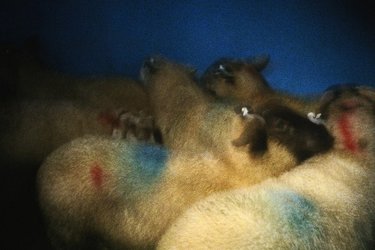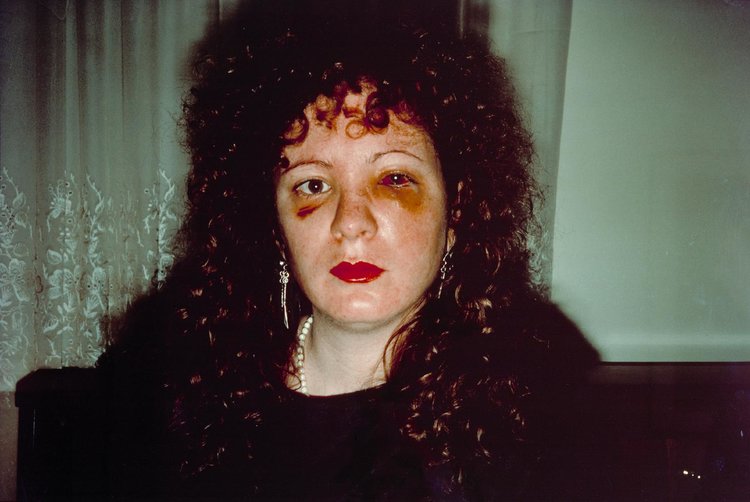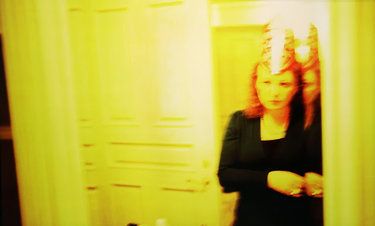Review | Nan Goldin’s “Weekend Plans” at IMMA
In her poem ‘One Art,’ Elizabeth Bishop wrote: “The art of losing isn’t hard to master,” a refrain that echoes through each stanza in the poem’s villanelle form, the narrator recording with mournful vigilance what is vanishing before her eyes. Loss has no definite shape or substance, and perhaps it is this ambiguity that prompted Bishop to try to cage it, so that it cannot recede and accumulate, like some dark tide, and rush roaring back to her.
Nan Goldin’s current exhibition at the Irish Museum of Modern Art, Weekend Plans is similarly concerned with memory, and the fear of forgetting seems to be as powerful a driving force in her photography. Located in IMMA’s West Wing, and running until October, the exhibition consists of a slideshow which features hundreds of photographs taken throughout Goldin’s life, as well as framed photographs of Goldin’s time spent in rural Ireland, resulting in an immersive and intimate experience.

Goldin rose to prominence in the 70’s in New York, where her photographs of subculture contributed to the creation of the ‘No Wave‘ movement. Her friends and lovers are shot along such a broad scale of confidentiality as to blend the trust required for her to shoot them kissing on a sofa and to shoot them deflated, ravaged, panting on a cum-stained bed. “It enables me to remember, “wrote Goldin in the introduction to ‘The Ballad of Sexual Dependency,’ a slideshow whose ever-changing contents and sequence resembles the mechanics of the mind, re-arranging memories in an effort to seal them in, if not certainty, then in familiar fragments.
Susan Sontag says that “people robbed of their past seem to make the most fervent picture takers,” and there are countless photographs in Weekend Plans that confirm Goldin’s place among that species. The fulvous Nan and Brian on the bed shows Goldin eyeing her lover as he sits up smoking in the morning light (featured image above), capturing an intimacy and a tension that is brought to brutal climax in the next photograph, Nan after being battered, NYC. By arranging the two together she displays the duality of memory, dropping from a nostalgic and fragrant moment of pleasure to how ugly and painful it can be to remember the humiliation and anger of betrayal.

Considering the myriad faces that populate her work, Goldin’s photographs of rural Ireland are sombre, meditative, and fathoms below the party and nightclub scenes Goldin is often associated with. Steeped in atmosphere and existential bliss, Lavender landscape, Buncrana is as hot of Donegal’s coast in crepuscular shades. The violet rocks and long, purple shadows express calm and sorrow no face ever could; the shapes that stretch across the wrinkled sea are like long footprints, marks of absence.
Another shot, On the boat to Tory Island shows the frame filled with waves, the distant mountains reduced to a blue hum in the background, and not a face or figure insight. Shots like these amplify the presence of people when they appear, and give their frozen moment a tenuous existence, like Goldin’s two self-portraits hung side-by-side, both of which resemble apparitions or faces suddenly appearing in a fire.
Goldin’s unfocused, blurry double stares back in Self-portrait on NYE; a warm, golden glimpse of her yielding to the festive naiveté, at once celebratory and mournful at time passing. Vivienne tripping in Galway combines its unfocused technique with its yipped-up subject to offer a landscape of lunar strangeness, the light slanted and slitting the sky to shreds, alien figures hovering in the background, and Vivienne wading through the blue air, keenly observed with a sisterly adoration by Goldin who finds strength in nostalgia, seeing the vague memory of her sister in Vivienne’s dizzy stroll.

Nowhere are absences made more palpable than in The Ballad of Sexual Dependency. The slideshow soars in its celebration of Goldin and her friends getting up to no good, lost in a tangle of limbs, dicks, and tits, heads thrown back and mouths open in howls of hedonism. One recurring face in Goldin’s photography is Cookie Mueller, who gazes at the mirror like a tired lioness, dolling herself up for yet another romp through the town.
Sontag wrote that “as photographs give people an imaginary possession of a past that is unreal, they also help to take possession of space in which they are insecure.” Apply this to the cast of queer figures throughout Goldin’s work and all the frivolity and facetiousness falls away: tacit toleration is not enough, queers will make legendary the nights spent fucking around and fucking up, and will turn it into art to make it last. Sontag acknowledged that “to photograph is to confer importance,” and that is no small thing to a section of society who drag a history of oppression behind them. Gradually the photographs begin to show less people and more needles sticking out of arms and taut tummies and, eventually, empty spaces; abandoned bedrooms and cold-looking crumpled sheets are evidence of blissful ignorance that has mutated into self-destruction. The long list of deceased friends that appears at the slideshow’s end confirms any viewer’s worst thought. Goldin lost many of her friends to AIDS-related illnesses, and her photographs hold them in moments of sleazy, supreme existence, free from any alienating gazer judgment.
“Photography is an elegiac art, a twilight art,” wrote Sontag, an observation that highlights both the sepulchral tone of Goldin’s photographs as well as their resistance against erasure, against being forgotten. Unlike her predecessor Diane Airbus, who shot from a distance and with questionable ethics, Goldin takes her pictures from within, sealing her and her gang’s lives in a merry-go-round of dizzy, blink-and-you-miss-it bliss.
Nan Goldin’s Weekend Plans runs in the Irish Museum of Modern Art until 15th Oct. 2017, in the West Wing.
Working Title/Artist: Nan and Brian in Bed, NYC
Department: Photographs
Culture/Period/Location:
HB/TOA Date Code:
Working Date: 1983
photographed by mma in 2002, transparency 4b (4×5)
scanned by film & media 3/8/05 (phc)
